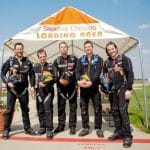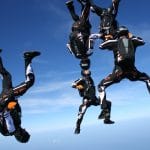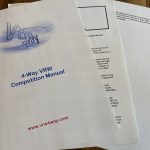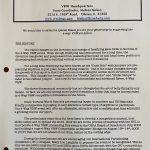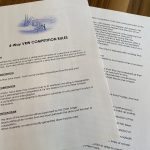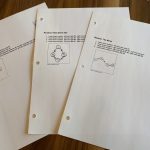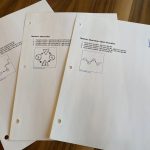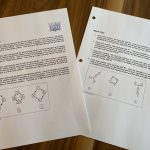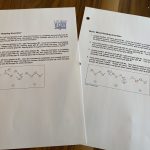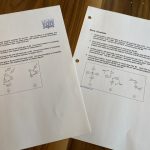The Origins of VFS
Posted on July 9, 2014
It was the winter of 2003, and I was alone in the 46,000-sqaure foot hangar called Skydive Chicago – bored. The temperatures neared freezing levels, snow covered the Skydive Chicago landing area in white, and the hallways were empty of eager skydivers. I distinctly remember thinking that I need to keep my hands busy and for some reason, I went to my computer and downloaded the USPA Competition Manual and read it word for word.
I competed in “Freestyle” in 1999-2003 and in “Freefly” with the Sugar Gliderz (Amy Chmelecki & Jen Key [2002-2004] then Brooke Schultz and Kate Hoffstetter [2004-2005]). Freestyle and Freefly are considered “Artistic Events” [AE]; which basically means the disciplines are judged subjectively. The creativity and ingenuity enhance the AE disciplines greatly! It’s the dedication to come up with something unique that makes these disciplines challenging, technical and progressive.
I found myself challenged to develop a routine satisfactory to judges, who weren’t necessarily current skydivers or even freesylists/freefliers, and be judged fairly. I wasn’t alone either; many other AE competitors complained of the same frustrations. Training, traveling and competing isn’t cheap. When it’s time to compete, you want a fair competition!
So here I am, nose in the Competition Manual thinking of more conversations….
I was at Perris Valley for a National competition in 2000 and remember joking with Eli Thompson, Mike Swanson, and my brother, Rook Nelson about how funny it was that freefliers jumpsuits had similarly progressed as RW had. Relative Workers used to wear big, balloon-type jumpsuits, then went to tight fitting jumpsuits with nylon fabric. I remember wearing a big pair of baggy jeans and a huge sweatshirt when I started learning to freefly because I couldn’t afford a jumpsuit. Now I wear a tight fitting Tonfly that mimics an RW suit!!
Still flipping through the Competition Manual.

Myself with Brian Buckland, Rook Nelson and Kyle Starck at the beginning of 4-way VFS Competition
Eli, Mike, Rook and myself talked about how freeflying would soon have a discipline like 4-way FS and that it was only a matter of time. I smiled. That conversation sparked several ideas that had stored in memory files in my head. But, was the sport ready for a new discipline – 4-Way Vertical Relative Work? It had to start somewhere.
“One of the reasons we had the conversation [at Nationals] about 4 way was not only because of the grippers but also because Stefania, Ippo, Olav, John Mathews, and myself had already been flying 4 way in Pahokee since 99. Once your brother [Rook Nelson] got there, he joined us in playing with new ideas figuring out what worked at the time and what didn’t. We were turning points, rotating pieces and flipping 4 ways. At the time it took the best people we could find to be able to pull these jumps off. It was super fun but it took the back burner since we were all training 3 way for the space games and eventually nationals and world championships once there was a Freefly category.” – Mike Swanson
I finished reading the competition manual and started trying to figure out the possibilities of 4-Way VRW. In that moment, I somehow elected myself to spearhead VRW. Why not? I had the time, resources, experience and motivation to do it. So I created a to-do list:
- Create a Vertical Dive Pool
- Judges
- How to train judges to “see” points vertically
- How to train judges to become VRW judges
- Spread the Word
- Get People Involved
- Go to events, show dive pool
- Load organize using dive pool
- Make website
- Attend Events
- Petition for the USPA BOD to support the event
- Get People Involved
- Host Events
- Go to USPA for support in seeing VRW as a discipline worthy of National recognition
- Get VRW into Nationals and in 2 years, International Competition
So that winter I created the dive pool and wrote the rules, put it together in a binder, made t-shirts, a website and a banner. Then, I was on the road. I went to many events such as Chick’s Rock, Nationals and World Records to promote the upcoming discipline. I did everything on my checklist.
“When we started Team Mandrin over the winter of 2004/2005, there were no other VFS teams around. In fact it wasn’t even called VFS, it was still VRW at that point. Skydivers had been freeflying for several years by then, but the only competitive disciplines that were out there were freefly or freestyle, both artistic. When the opportunity presented itself to help pioneer a brand new discipline, we jumped on it! – Brian Buckland
“After a particularly disappointing event in California in 2004, we [Dave Brown, Brian Buckland, Kyle Starck, Jon Pinyon] started talking about the four of us getting together at random DZs and busting out a bunch of jumps for a weekend, coming up with sequences of medium to difficult formations and trying to execute them, just the four of us. No plans for competition, we just wanted to hone our skills.
“A few weeks later we became aware of something called “vertical relative work” that Melissa Nelson had been working on. We downloaded it and set a date to meet up in Atlanta to try it out… officially calling ourselves a skydiving team for the first time.” – Eric Deren
Dave Brown, Brian Buckland, Kyle Starck, Jon Pinyon and Eric Deren were my biggest supporters and together they created the VRW team known as “Mandrin.” They trained – a lot. They were the first engineers of how VRW worked and Buckland was the first cameraflyer to train a 4-Way VRW team.
There were many nah-sayers along the way, saying that “VRW” was too progressive and there’s no way the video guy would be able to film all the points. The negative feedback made me even more excited that there was going to be new territory to be discovered in the sky – and the camera flyer was going to have to be a badass flyer too!
“Being the first official VFS camera flier was an amazing experience. It was an honor to say the least, but took a lot of figuring out seeing that no one else had ever done it before. I can still hear my teammates telling me ‘steeper…steeper’ during our debriefs. Tweaking the camera angles and learning how to get all of the grips visible was indeed a challenge. At the same time we were trying to apply the training methods that have been honed over the years in traditional belly 4-way FS. We engaged multiple FS coaches to help us learn how to train and for me, how to film.” – Buckland
- Team Mandarin
- Photo by Raymond Adams
- Team Mandarin
- Photo by Raymond Adams
Deren had been my informant on what worked and didn’t work. But it was a difficult transition being the original author and having it all come to fruition. I did not have the capabilities at the time to travel or train what I had written. Phone conversations were meaningless because I couldn’t understand or see what was going on in the sky. Mandrin ultimately became a key to VFS’s success.
“Everyone who didn’t live in Atlanta flew in, and we went to the DZ. After we missed more than one 40 minute call trying to figure out what the hell the diagrams and descriptions were meaning, and calling the author up for clarification without success, we spent the rest of the weekend just flying some of the more unambiguous formations. After that weekend, I took charge and took on the task of taking the ambiguity out of the formations, and then I designed the formation diagrams in the computer, modifying them to match what I knew from 4-way FS… as well as renaming it to VFS to match the IPC nomenclature for formation skydiving.” – Deren
During this time I gained about 800 signatures on my petition for USPA and I attended a BOD meeting with Deren.
I’d been to several USPA BOD meetings throughout the years and am the daughter of the late pioneer, Roger Nelson. For those of you that don’t know him, he was extraordinarily progressive in his teaching methods. When USPA told him he couldn’t do something (such as jump square mains for students), he’d do it anyways. So I anticipated meeting the same kind of resistance he had in the past. After our presentation, I was astounded by USPA’s backing to help see the vision into fruition for competition (which ultimately relied much on Deren’s input afterwards).
Looking back, the first 4-way Freefly competition was held at Space Games in Pahokee. “It was artistic but it was four way.” – Mike Swanson. Then, in 2006, 4-Way VFS was included at USPA’s National’s at Skydive Arizona as a test event. Only one category, the gold for the taking, and an overwhelming number of teams (9) came in support of the new discipline. The success was astounding.
“In 2006 I [Buckland] accepted the job of being the US Parachute Team’s – Team Manager for Artistic Events at the World Parachute Championships in Gera, Germany. I went there with two things in mind, the first was obviously to support the US Team. The second reason was to recruit some of the best freefliers in the world and expose them to VFS. Eric Deren joined me in my quest and we arrived at the Worlds with DVD’s of all of the VFS competitions held to date, every jump on video as well as copies of the current dive pool. We handed these to anyone who was interested. Eric and I held a meeting with all of the freefliers and delegates from around the world that expressed that interest and showed them what we were doing in the USA, answered questions and gave them guidance so they could start VFS in their country and get it as a discipline at their Nationals. It was a huge success and very well received.” – Buckland
Shortly afterwards, VFS 4-way was adopted as an addition to FAI world competitions, the first being the FAI World Cup in Eloy, AZ, in October 2008 with the help of Deren; exactly 2 years later from the first competition, it was seen as an International discipline.
VFS truly started with the Pahokee gang in the late 90s. “I believe it was a couple years after all this that you took charge and did what no one else was willing to do and made it a actual discipline.” – Swanson. It was because of the conversations we had at that 2000 Nationals that brought VFS where it is today. I originally handed off the baton to Deren in 2004/2005 since I was not a full-time VFS competitor and that I had many other projects that also took up my time. Deren and Team Mandrin stopped competing by 2008. By then, VFS had “grown up.”
At the 2010 USPA Nationals at Skydive Chicago, Skydive TV did an interview on the origins of VFS and dubbed me, the “Godmother of VFS.” Flattering, but it took me, the Pahokee Gang [Olav Zipser, Stefania Martenego, Ippo Fabbi, Mike Swanson, John Matthews, Rook Nelson and a few others], Mandrin, Eric Deren, Brian Buckland, Dennis Cowhey, and all the past and current competitors to make it happen, and keep it going.
At the 2011 World Meet in Dubai, nine teams from around the world competed.
“The best part of being on Team Mandrin wasn’t just the fact that we were able to pioneer a new part of our sport, but being able to sit back year after year since the team’s inception and see more and more VFS teams become major players over the years. The limits keep getting pushed and now VFS is a globally recognized disciplined practiced and competed in by hundreds of skydivers around the world and the best part about it is that it’s only getting bigger.” – Buckland
Here’s to another decade of progressive flying! May we always keep learning and be entertained in the sky!


